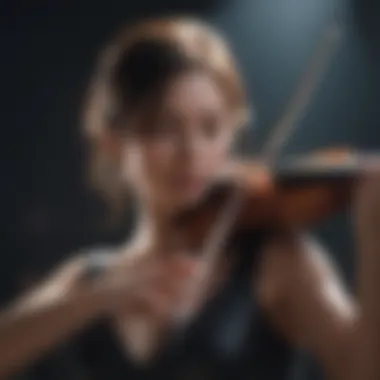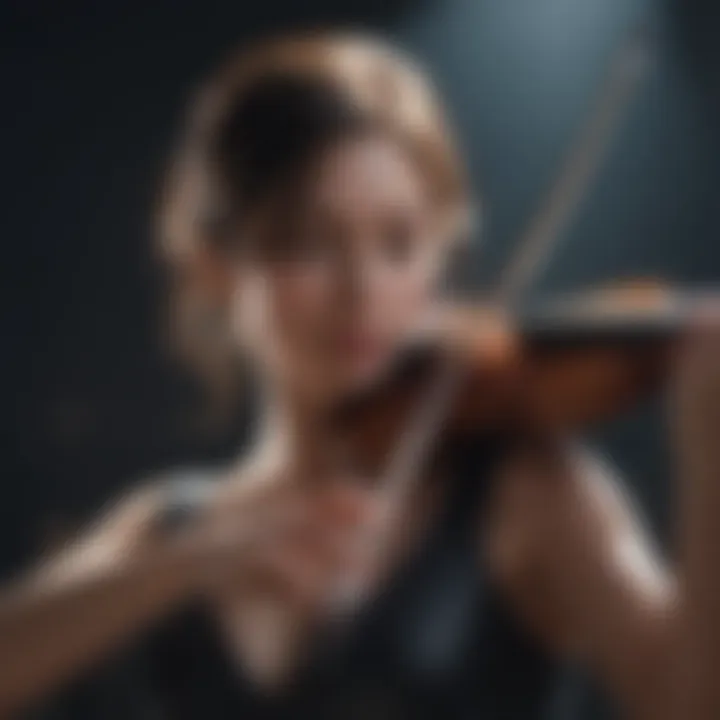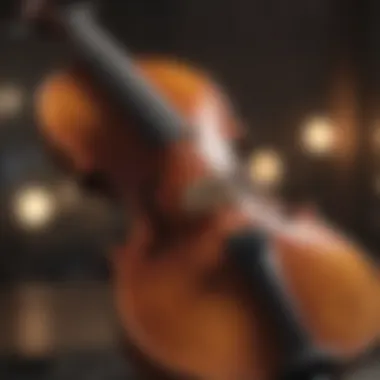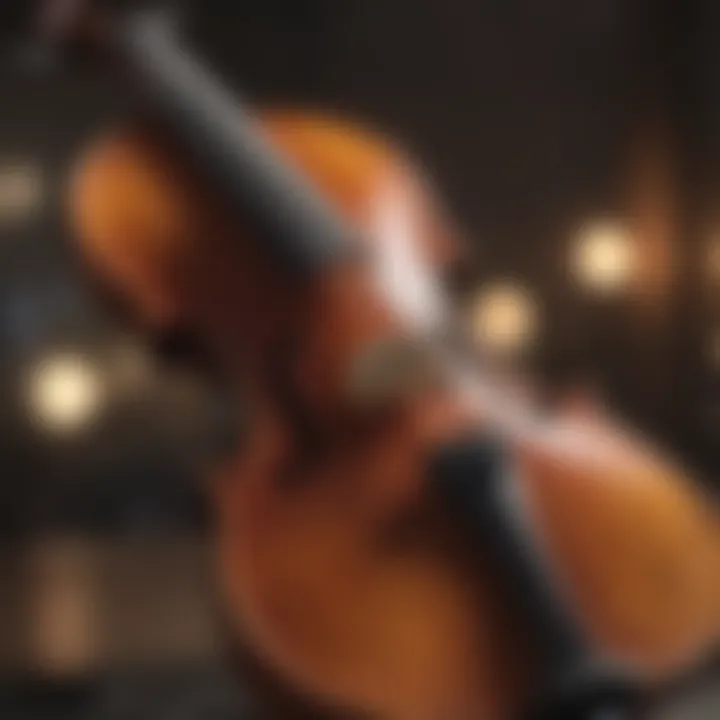Exploring the Significance of Violin Music Across Genres


Intro
The violin has a unique presence in the world of music. It adds depth and emotion to various genres, from classical to contemporary. Its ability to express complex feelings makes it one of the most cherished instruments. This article aims to explore the significance of violin music, analyzing its impact on different musical styles, as well as its technical and expressive aspects.
Through the study of iconic compositions and techniques, we can better understand the violin's role in shaping the musical landscape. This analysis will be beneficial for music lovers, aspiring musicians, and anyone interested in the violin's diverse contexts.
Artist Profile
Biography and Background
To understand the essence of violin music, it’s crucial to recognize the artists who have influenced its evolution. Numerous violinists have dedicated their lives to mastering this art. Each artist carries a unique background that shapes their style.
For example, renowned violinist Itzhak Perlman was born in Tel Aviv, Israel, and has overcome significant challenges to become a celebrated performer. His experiences and environment have greatly influenced his interpretation of pieces. Often performing both classical and contemporary works, Perlman bridges the gap between tradition and modernity.
Major Influences and Inspirations
Artists often draw from various influences. For instance, some might find inspiration in folk music, while others lean toward classical or jazz. These influences create a rich tapestry of sound, allowing the violin to adapt seamlessly across genres.
Modern violinists like Lindsey Stirling have also contributed to this evolution by combining classical techniques with electronic music styles. Their creativity opens new avenues, inviting younger audiences to appreciate violin music.
"The violin, when mastered, can convey the human experience in a way that few instruments can."
Song Analysis
Theme and Lyrics Breakdown
When analyzing songs featuring the violin, it’s essential to look at the themes they convey. Many compositions explore love, loss, and joy, using the violin to enhance emotional resonance. The themes may vary widely, but the way these songs communicate feelings remains a constant.
For instance, pieces like Vivaldi's "Winter" from The Four Seasons depict the bitterness of winter weather. The somber tones and swift notes vividly illustrate the harshness of the season, showcasing how the violin can narrate stories without words.
Instrumentation and Composition
Effective use of instrumentation is key to the power of violin music. In orchestras, the violin often plays a lead role, guiding the overall sound. Composers carefully weave together strings, brass, and percussion, allowing the violin to shine.
Chamber music is another important aspect of violin repertoire. In smaller ensembles, the interactions between instruments amplify the violin's voice, creating intricate dialogue. Pieces by composers like Mozart demonstrate this balance beautifully, where the violin often engages in a musical conversation with other instruments.
With this understanding, we can appreciate how violin music not only shapes the emotional content of a song but also establishes its unique character.
The Role of the Violin in Music
The violin holds a distinctive place in the landscape of music. Its versatility is unparalleled, allowing it to seamlessly transition across various genres. This flexibility enables the violin to contribute to different musical expressions, enriching the soundscapes of diverse styles. As we explore this instrument, a broader understanding emerges, highlighting not only its technical appeal but also its emotional depth.
History of the Violin
The history of the violin is a fascinating narrative beginning in early Renaissance Italy. It evolved from earlier string instruments like the rebec and the viola da gamba. The craftsmanship of luthiers such as Antonio Stradivari and Giuseppe Guarneri set the benchmark in violin making. These historical instruments shaped the foundation of violin music that we know today. Through centuries, the violin has been an embodiment of technical advancements, influencing its sound and playability.
The Violin Across Genres
Classical
In classical music, the violin is often seen as a leading voice. It possesses a wide range of expressiveness, allowing composers like Bach and Vivaldi to utilize its capabilities fully. The key characteristic of the classical violin lies in its formal training and structured compositions. This structured approach makes classical violin music a popular choice for audiences seeking purity and depth in musical expression. The focus on technique can enhance a player’s skill but may limit artistic freedom in some interpretations.
Folk


Folk music, on the other hand, presents a different narrative for the violin. It often serves as a storyteller, connecting listeners to cultural roots and traditions. The key characteristic of folk violin is its improvisational nature; musicians interpret and express emotions drawn from real-life experiences. This aspect makes the folk violin a compelling choice for audiences who appreciate authenticity. However, the informal structure may challenge musicians seeking technical mastery.
Jazz
The jazz genre showcases the violin's adaptability. It is typically not a dominant instrument, yet notable violinists like Stéphane Grappelli have carved a niche in this space. The improvisational aspect of jazz allows the violin to stretch its boundaries. The key characteristic here is creativity—musicians experiment with notes and rhythms. This unique flexibility encourages innovative expressions but may also intimidate those who are more classically trained.
Contemporary
Contemporary music is perhaps the most exciting realm for the violin. It blends traditional techniques with modern influences, creating a rich tapestry of sound. The key characteristic of contemporary violin music is its willingness to embrace new genres, including electronic and pop. This blend attracts a younger audience and makes it a beneficial choice for those looking to diversify their musical palette. However, it may also dilute some classical elements that traditionalists hold dear.
Cultural Significance
The cultural significance of the violin is profound. It often serves as a bridge between generations and communities. In numerous cultures, the violin is more than an instrument; it is a symbol of identity and heritage. It plays a critical role in celebrations, ceremonies, and communal gatherings, promoting unity and shared experiences. As we delve into the world of violin music, the cultural layers further enrich our understanding of its evolving role in society.
Iconic Violin Compositions
The discussion of iconic violin compositions is crucial for understanding the depth and variety within violin music. These pieces not only showcase the technical prowess needed to master the violin but also reflect the emotional breadth the instrument can convey. They serve as benchmarks for aspiring musicians, providing insight into musical structure and historical context. Compositions like Vivaldi's "Four Seasons" and Bach's "Solo Violin Sonatas" are not just notes on a page; they are vivid expressions of the human experience. The study of these works reveals how violin music has evolved and adapted across genres and eras, making them essential in the journey of any music lover.
Vivaldi's Four Seasons
Vivaldi's "Four Seasons" is one of the most recognizable works in the classical music repertoire. Composed in the early 18th century, this set of four violin concertos captures the essence of each season through musical motifs. Vivaldi employs vivid imagery, with each concerto reflecting the natural changes and moods associated with spring, summer, autumn, and winter. The use of different tempos and dynamic contrasts in these pieces allows performers to explore a vast range of emotions. For students, playing pieces from "Four Seasons" enhances their understanding of phrasing and expression, which are vital in violin performance.
Bach's Solo Violin Sonatas
Bach's "Solo Violin Sonatas" are seminal works in the violin repertoire. Composed during the Baroque period, these sonatas present a unique challenge for violinists due to their intricate counterpoint and demanding finger techniques. Each sonata is a testament to Bach's compositional genius, highlighting the violin's capacity for both melodic and harmonic expression. Being able to perform these pieces demonstrates a high level of technical ability and interpretative skill. Furthermore, these sonatas provide a strong foundation for any violinist as they explore themes of structure and improvisation.
Famous Concertos
Tchaikovsky's Violin Concerto
Tchaikovsky's Violin Concerto is celebrated for its lyrical beauty and technical demands. Written in the late 19th century, it stands out for its emotional depth and lush orchestration. The concerto's first movement features sweeping melodies and powerful orchestral support, making it a favorite among both performers and audiences. Its key characteristic lies in the interplay between the violin and the orchestra, allowing for dramatic solos that resonate with passion. This piece is often chosen for competitions due to its widespread recognition and challenges it poses. The blend of technical difficulty and emotional expressiveness makes Tchaikovsky's work a beneficial choice for demonstrating the violin's capabilities.
Mendelssohn's Violin Concerto
Mendelssohn's Violin Concerto is another cornerstone of the violin repertoire, known for its graceful melodies and innovative structure. Composed in the 19th century, it broke away from traditional concerto form by seamlessly incorporating the soloist's entrance with the orchestra. The key characteristic of this concerto is its lyrical themes, which exhibit a lightness and charm that are both captivating and enjoyable to perform. This piece is popular among students and professionals alike, providing a platform for exploring lyrical playing and dynamic contrast. The spirited finale brings the work to a breathtaking close, showcasing the violinist's technical skill and artistry, making it a must-learn for serious musicians.
"Studying these iconic compositions not only enhances a violinist's technique but also enriches their understanding of musical history and expression."
By delving into these iconic works, musicians gain insights into the technical foundations and expressive possibilities of the violin. Through the lens of these compositions, one can appreciate the instrument's richness and significance in the larger scope of music.
Techniques in Violin Performance
Understanding the techniques in violin performance is crucial for any violinist who wants to excel in the art of playing. Techniques enhance a player’s musical expression, allowing them to convey emotions and connect with their audience. Whether one seeks to perform classical pieces or modern compositions, mastering these techniques can significantly impact the sound produced. Additionally, a solid grasp of violin techniques results in better control over the instrument, leading to overall improved performance.
Bow Techniques
Staccato
Staccato is characterized by its sharp and detached notes. This technique involves playing notes in quick succession but cutting them short, allowing for a crisp sound. Staccato adds a playful and lively quality to violin music, making it especially effective in fast-paced compositions. It is a popular choice for many pieces because it creates a distinct rhythmic pattern.
One unique feature of staccato is that it can be executed using different bowing speeds and pressures, which affects the overall tone. While its advantages include adding excitement and building momentum, the downside is that it can be challenging to maintain clarity, especially in complex pieces. Proper practice is essential to avoid a muddied sound.
Legato


Legato, by contrast, emphasizes a smooth, connected sound between notes. When executing legato, the player maintains a continuous bow stroke for each group of notes, producing a flowing line that is essential for lyrical passages. This technique is beneficial for conveying emotions, making it a vital choice in many pieces.
The smoothness of legato is unique, as it allows for subtle dynamic changes and expressive nuances. However, achieving a pure legato requires precise control over bow speed and pressure, which can be difficult for beginners. Some players may struggle with inconsistent bowing, leading to uneven tone production.
Spiccato
Spiccato is distinguished by its bounce. The bow barely touches the strings, creating an airy sound. This technique is particularly effective in lively and dynamic sections of music, adding an element of fun. Spiccato allows performers to play faster passages with ease while preserving clarity.
One unique aspect of spiccato is its versatility. It can be used in both classical and contemporary music styles, making it a valuable technique to master. The main disadvantage is that it requires precise bowing control; if not done correctly, the resulting sound can quickly become tedious and lose its intended effect.
Finger Techniques
Vibrato
Vibrato is a crucial element that adds warmth and depth to notes. This technique involves a slight oscillation of the finger on the string to create a rich sound. Vibrato allows a musician to express emotion and character in their music, elevating a performance.
The key characteristic of vibrato is its capability to enhance the expressiveness of each note. It is often seen as an indicator of a mature playing style. The downside is that achieving a consistent vibrato requires time and practice, as inconsistency can detract from the musical impact. Musicians may find it challenging to balance vibrato with precision.
Double Stops
Double stops involve playing two strings simultaneously. This technique enriches the harmonic texture and expands the sonic palette available to violinists. Double stops are found in various musical styles, making them especially valuable for both classical and modern interpretations.
The unique feature of double stops is their ability to create fuller harmonies without needing an accompanist. However, they can be technically demanding. Beginners may struggle to produce a clean sound on both strings, and this can be discouraging. Mastery of double stops requires practice and focus to develop finger placement and bowing technique.
Expressive Playing
Expressive playing is an integral aspect of any performance. It encompasses the use of dynamics, phrasing, and articulation to convey emotion effectively. Violinists use expressive techniques to bring life to the music, allowing for personal interpretation. These skills are essential for engaging an audience and making a memorable impact.
A focus on expressive playing not only enhances the connection between performer and audience but also fosters individual artistic identity. Mastering techniques for expressivity requires ongoing practice and exploration, ensuring that every performance resonates with depth and intention.
The Evolution of Violin Music
The evolution of violin music is important for understanding how this instrument has adapted and changed over time. It reflects the dynamic nature of musical styles and the context in which violinists operate. The development of violin music impacts both the technical skill required to play and the genres it influences.
Historically, the transition from Baroque to Romantic styles marks a critical turning point. This shift is characterized by changing artistic expressions. The violin's role evolved from being a supportive instrument in orchestras to a prominent solo voice capable of conveying deep emotions.
As music progressed into modern times, innovations emerged. The adoption of technology began to influence how the violin was played, leading to new genres and styles. Understanding these transformations provides insight into the current violin landscape.
Baroque to Romantic Transition
During the Baroque period, the violin was commonly used within an ensemble setting. Composers like Antonio Vivaldi and Johann Sebastian Bach showcased the instrument's potential. They wrote intricate pieces that highlighted both technical skill and expressive capabilities. The focus was often on harmony and counterpoint, allowing the violin to interweave with other instruments.
As the Romantic period approached, composers like Johannes Brahms began to emphasize the individual voice of the violin. The emotional depth of the music took priority. Violinists started to explore new techniques to express feelings, such as vibrato and varying bow pressure. This transition was pivotal, as it broadened the violin's expressional range and its status in music.
Modern Innovations
The landscape of violin music continues to evolve today, notably through remarkable innovations.
Electric Violins
Electric violins have transformed how music is produced and perceived. These instruments allow for significant amplification, enabling violinists to perform in larger venues without sacrificing sound quality. The key characteristic of electric violins is their ability to shape sound electronically, often incorporating effects like reverb and distortion.
This adaptability makes electric violins popular among contemporary musicians. They can explore various genres, including pop, rock, and electronic music. However, their sound may not appeal to purists who prefer the traditional acoustic tone. Electric violins are versatile tools, yet they can create a distinct separation from classical roots.


Experimental Genres
Experimental genres represent a creative approach in violin music. Musicians experiment with nontraditional techniques and forms. This innovation often challenges conventions and encourages exploration beyond classical boundaries. The key aspect of experimental genres is their willingness to blend influences from many styles, including jazz and world music.
These genres offer an exciting avenue for expression, fostering collaboration among artists from diverse backgrounds. However, they may not resonate with those who seek conventional forms of violin music. Experimental genres represent the forward-moving spirit of violin music, pushing its limits.
The evolution of violin music showcases adaptability and innovation, reflecting broader musical trends while continually evolving to meet the demands of modern audiences.
In summary, the evolution of violin music from Baroque to modern innovations reveals a rich tapestry of influences and transformations. Understanding this evolution is crucial for appreciating the violin's current and future role in music.
Contemporary Violinists and Their Influence
The realm of violin music is not static; it evolves with each generation. Contemporary violinists embody this transformation, merging traditional techniques with modern influences to redefine the instrument's role in today’s music landscape. Their contributions not only enrich the violin repertoire but also inspire a new wave of musicians and audiences. Understanding the influence of these artists is essential for appreciating how the violin adapts to various genres and cultural contexts.
Prominent Artists
Yo-Yo Ma
Yo-Yo Ma, while primarily recognized as a cellist, is notable for his collaborations with violinists and his versatile approach to music. His ability to traverse different musical genres, including classical, folk, and even contemporary pop, aligns with the broader understanding of how string instruments can interact dynamically within a diverse soundscape. The key characteristic of Yo-Yo Ma is his profound expressiveness and ability to communicate emotions through music.
His unique feature lies in his collaborative spirit; he often works with other musicians across disciplines. This collaboration brings fresh perspectives to traditional music forms. The advantage of including him in discussions about violin music is his vision for integration across genres, which encourages an appreciation for musical diversity. However, it can be argued that his prominence as a cellist sometimes overshadows his input on violin compositions.
Itzhak Perlman
Itzhak Perlman is widely regarded as one of the greatest violinists of our time. His technical prowess and unmistakable sound have left a significant mark on violin performance. Perlman's key characteristic is his ability to connect intimately with audiences. He brings an emotional depth to even the simplest of pieces. He is a beneficial figure in any discussion about contemporary violin music due to his longstanding career and consistent contributions to both classical and popular musical forms.
A unique feature of Perlman's approach is his commitment to education and sharing expertise. Through masterclasses and performances, he nurtures upcoming talent, ensuring the survival of quality musicianship. The advantage of including Perlman in this article is his status, which lends credibility to discussions on violin music. However, some may view his interpretations as traditional, which might not resonate with all modern audiences.
Emerging Talents
Emerging violinists bring a fresh vibrancy to the music scene. They often break conventional barriers by integrating technology and new genres. Their innovative ideas can challenge established norms in violin music. This section emphasizes their vital role in the future of violin music, showcasing unique styles and perspectives that may inspire a new generation of musicians. As they explore different cultural influences and artistic expressions, these talents push the envelope on what is possible with the violin.
"The future of violin music lies in the hands of those who dare to innovate."
This quote speaks to the spirit of contemporary musicians who are not afraid to merge the old with the new, creating a richer tapestry of sound that resonates with diverse audiences. Lesser-known violinists, who may not yet have mainstream recognition, deserve attention as they offer new approaches and interpretations, namely through social media platforms and music streaming services.
By appreciating both established and emerging talents, we can gain a holistic view of the violin's ongoing evolution in contemporary music.
The Future of Violin Music
The future of violin music is a crucial aspect of this article because it reflects how the instrument adapts to changing the musical environment. As technology continues to develop, the ways in which music is created, shared, and performed evolve as well. Violinists must not only hone their craft but also embrace these changes to remain relevant. The intersection of technology and music offers new opportunities, while global collaboration brings diverse influences, enriching violin music for new generations.
Adapting to Technology
Technology plays a significant role in shaping the future of violin performances and compositions. One of the primary ways technology impacts the violin is through the creation of electric violins. These instruments allow for amplified sound and can produce a wider range of tones compared to traditional violins. This innovation benefits not only soloists but also orchestras, enabling a richer and more layered sound.
Furthermore, digital platforms for learning and performance have emerged. Websites like YouTube and Reddit serve as effective learning tools, allowing aspiring violinists to access tutorials and performances by master musicians worldwide.
In recent years, software such as Finale and Sibelius offers composers advanced tools for writing and arranging music. This has opened new avenues for innovation in violin compositions and arrangements. The ability to create and share music digitally fosters a global community of musicians who can collaborate without being limited by geography.
Global Collaboration
Global collaboration has become a defining characteristic of contemporary music. For violinists, this trend results in the blending of cultural influences that enhance musical expression. Artists are increasingly participating in cross-genre collaborations, combining classical elements with pop, jazz, and folk traditions. This fusion enriches the violin's repertoire and introduces new techniques and styles of playing.
Through online platforms, musicians from diverse backgrounds can connect easily. They can share ideas, styles, and even co-write pieces that feature the violin in unique ways. These collaborations are not only educational but also inspire creativity and innovation.
The importance of global collaboration is evident in projects that bring together artists from various countries. For example, a duet between a classical violinist from Europe and a folk musician from Asia can create an entirely new sound that reflects both traditions. Such projects demonstrate the capacity of the violin to adapt and remain relevant in a multicultural musical landscape.
Ultimately, the future of violin music rests on a foundation of adaptability and collaboration. By understanding and embracing technological changes while fostering connections across cultures, musicians can ensure that the violin continues to thrive and inspire future generations.







